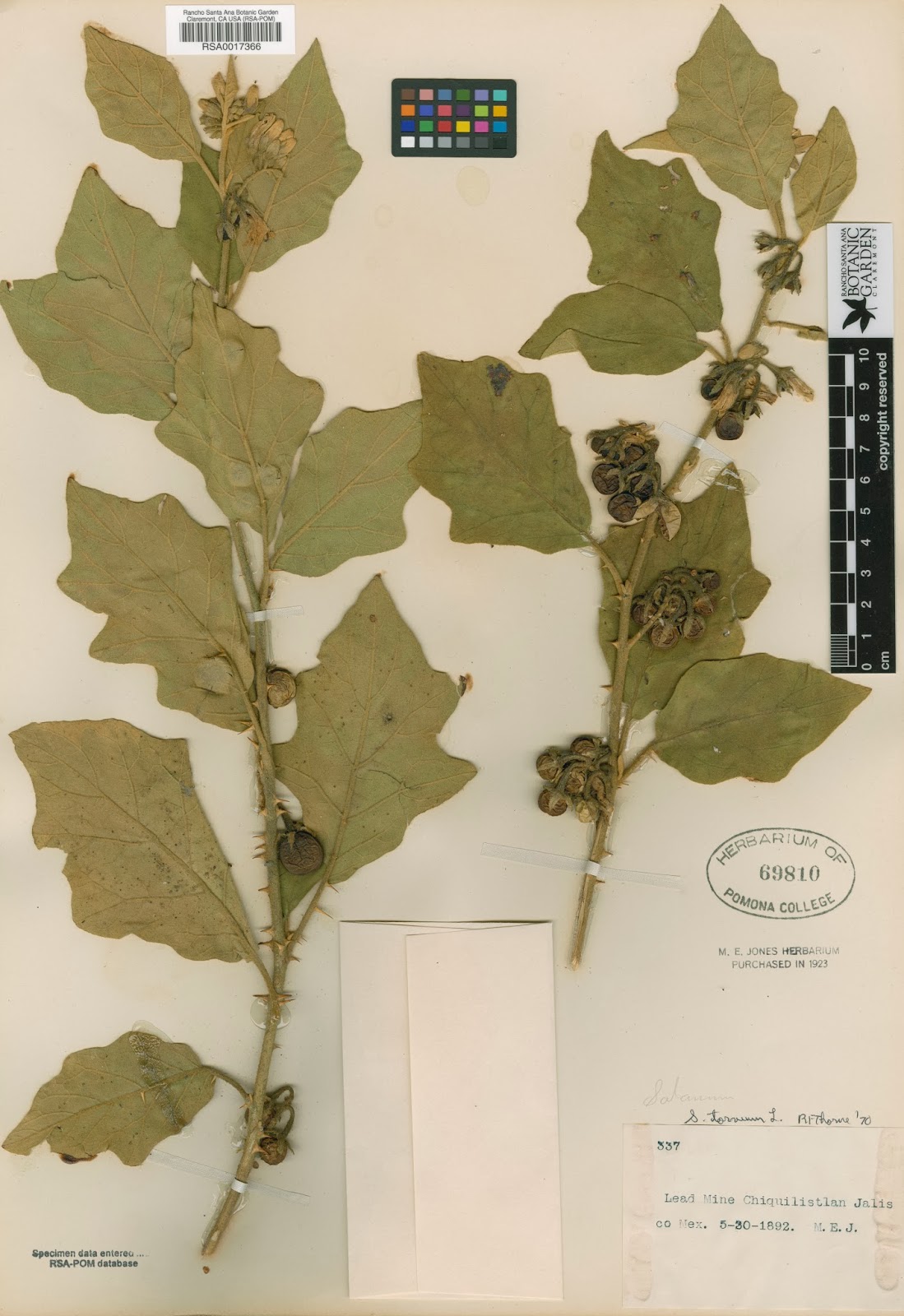 |
| Acacia hindsii, collected in Mexico, 1892 |
Marcus E. Jones (1852–1934) was one of the most prominent
botanists of the American West. Jones collected thousands of plants, and
photographed and recorded detailed notes of the regions he traveled in. Jones’
plant collecting at the turn of the century provided an early
comprehensive characterization of the flora of the West; he collected in
areas that were poorly known, some of which have since been
developed. Jones was also a skilled plant taxonomist who described hundreds of
new species, many of which are represented as type specimens (a specimen
selected to serve as a reference point when a plant specimen is first named)
and are housed in our herbarium at Rancho Santa Ana Botanic Garden (RSABG).
 |
| Jessica Chairez, entering specimen records into database |
In 1882, outlaw Jesse James was killed by Robert Ford,
Thomas Edison created the first string of Christmas tree lights, Robert
Koch discovered the germ that causes tuberculosis, and Arizona ,
Colorado , Utah ,
New Mexico , Montana ,
and Idaho ,
among others, had yet to achieve statehood. 1882 is also the year that Marcus
E. Jones took the first of several botanical trips to Baja California , Mexico
The plant collections and archives from Jones’ trips to Mexico (one in
1882, a second in 1892, and four trips during 1926–1930) are the focus of an
ongoing project in the herbarium and library at RSABG: to research and digitize
the most important portions of the Jones specimens and archival collections.
The herbarium houses an estimated 100,000 specimens collected by M. E. Jones
(originally purchased by Pomona College in 1923 and later transferred to RSABG),
representing plants from western United States ,
California , and Baja California , Mexico
 |
| Solanum torreanum, collected in Mexico, 1892 |
Digitizing Jones’ specimens involves a series of steps:
specimens are located and pulled from the main collection in the herbarium;
each specimen is barcoded and databased (in which information on the collection
label is recorded in our herbarium database); the specimen is then imaged using
an inverted scanner (to prevent from having to turn a specimen over). It takes
approximately four minutes to produce a high-resolution image of the specimen.
To date, we have databased and imaged more than 1000 specimens in the
herbarium. The images and data associated with these specimens (metadata) are
now available through the Global Plants Initiative through JSTOR, a shared
digital online library (http://plants.jstor.org).
In the library, preservation of the Jones collection
involves cleaning, labeling, and accessioning the contents of the Jones
archives. Glass slides, negatives, and photographs are stored in protective
sleeves, and the pages of photo albums are protected with sheets of archival
tissue sandwiched between. Each item is accessioned and organized in archival
quality boxes. Descriptions and metadata of all archived items are captured in
an electronic database. In addition, we have imaged archived objects (such as glass
slides and negatives, photographic prints, correspondences, diaries, and
notebooks) using similar methods for herbarium specimen imaging.
 |
| Rachel Poutasse, preparing a specimen for scanning |
Many of our herbarium staff, graduate students, and
volunteers at the Garden have been involved in various aspects of the Marcus E.
Jones project. Curatorial Assistant Jessica Chairez has largely led the charge,
overseeing nearly all aspects of the project, including data entry, imaging
specimens, compiling metadata, processing the archives collection, and training
students and volunteers. Graduate students Diana Jolles, Forrest Freund, and
Manuel Lujan have participated in pulling specimens, databasing, and imaging.
Volunteer Robert Swank has assisted with archiving the photographs and photo
books. A new addition to the project, volunteer Marilyn Irwin, has recently
been trained to image herbarium specimens. The dedicated efforts of staff, students,
and volunteers helped to make digitizing the first thousand specimens of Marcus
E. Jones collections possible. And we are already well underway of digitizing
our second thousand!
For more information about the life of Marcus E. Jones, see:
Ertter, B. 2001. Native California Roses. Discovery of Rosa minutifolia Engelm. “Ensenada Rose.” Accessed at http://ucjeps.berkeley.edu/ina/roses/minutifolia.html
Lenz, L. W. 1986. Marcus E. Jones: Western Geologist,
Mining Engineer and Botanist. Rancho Santa Ana Botanic Garden ,
Claremont , CA
Rush, E. 2007. Marcus Jones: an outspoken maverick
(1852–1934). Fremontia 35: 9–13.